Airdrie & New Monkland Area
Information specific to this area can be found below and on the left
menu bar. We also recommend consulting the many general pages for
information of general relevance to miners' lives.
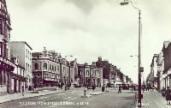
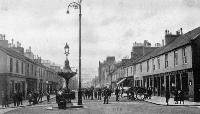
Above Left, The Cross Airdrie; Above Right Old Cross & High St Airdrie c1912
Below Left, Anderson St; Below Right Commonside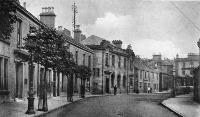
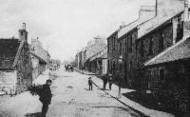
Below left: New Town Cross c1905, Right Bank St, c1906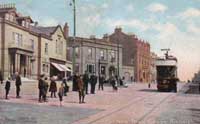
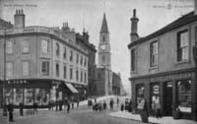
Ordnance Gazetteer of Scotland, Francis H Groome
 Airdrie (Gael, airde-reidh, 'smooth height'), a parliamentary and municipal burgh in New Monkland parish, NE Lanarkshire, 2 miles E by N of Coatbridge, 11 E of Glasgow, and 32 W by S of Edinburgh. It stands on the great highroad between the two cities, with which it also communicates by the North British railway, having one station (South Side) on the main Bathgate line, and another (Commonhead or North Airdrie) on the Slamannan branch, 16 miles WSW of Manuel Junction. With Glasgow it is further connected by the Monkland Canal, extending to Calder ironworks, 1 1/2 mile to the SSW. Lying between two rivulets, on the side of a hill with a south-westward slope from Rawyards (624 feet above sea-level) to Coatdike (361 feet), Airdrie consists of a principal street running 1 mile E and W along the highroad, with minor parallel or divergent streets ; and though well paved and lighted, airy, and regularly built, it wears a straggling and somewhat unlovely aspect. Chalmers identified its site with Ardderyd, the battlefield of Rhydderch and Gwendolew (573); but Ardderyd or Arthuret is far away in Cumberland (Skene, Celt. Scot., i. 157), and the first that we hear of Airdrie is its erection into a market-town by Act of Parliament in 1695, with the privilege of holding a weekly market and two yearly fairs. Down even to the close of last century it was merely a large village, and its rapid expansion during the next five decades was due to the opening up of the rich beds of coal and ironstone around it, to facilities of communication with the markets and outlets of the West, and to its share in the weaving orders of Glasgow manufacturers. It was made a burgh of barony in 1821, one of the five Falkirk parliamentary burghs in 1832, and a municipal burgh in 1849; prior to 1871 it partly adopted the General Police and Improvement Act. Governed by a provost, 3 bailies, and 12 councillors, with treasurer, town-clerk, and procurator-fiscal, Airdrie unites with Falkirk, Hamilton, Lanark, and Linlithgow, in returning 1 member to parliament; and its municipal and parliamentary constituency was 1802 in 1881. Airdrie has a post office, with money order, savings' bank, insurance, and telegraph departments ; branches of the Bank of Scotland, and of the Clydesdale, National, and Royal banks; a temperance and a penny savings' bank, 27 insurance offices, a gas-light company, a water company, conjointly with Coatbridge, a fire brigade, a prison (legalised 1859; 51 cells), a fever hospital, 3 hotels, a race-course, and two Saturday newspapers—the Airdrie Advertiser (1855) and the Airdrie and Coatbridge Telegraph (1879). Tuesday is market-day, and the fairs are on the last Tuesday of May and the third Tuesday of November.
Airdrie (Gael, airde-reidh, 'smooth height'), a parliamentary and municipal burgh in New Monkland parish, NE Lanarkshire, 2 miles E by N of Coatbridge, 11 E of Glasgow, and 32 W by S of Edinburgh. It stands on the great highroad between the two cities, with which it also communicates by the North British railway, having one station (South Side) on the main Bathgate line, and another (Commonhead or North Airdrie) on the Slamannan branch, 16 miles WSW of Manuel Junction. With Glasgow it is further connected by the Monkland Canal, extending to Calder ironworks, 1 1/2 mile to the SSW. Lying between two rivulets, on the side of a hill with a south-westward slope from Rawyards (624 feet above sea-level) to Coatdike (361 feet), Airdrie consists of a principal street running 1 mile E and W along the highroad, with minor parallel or divergent streets ; and though well paved and lighted, airy, and regularly built, it wears a straggling and somewhat unlovely aspect. Chalmers identified its site with Ardderyd, the battlefield of Rhydderch and Gwendolew (573); but Ardderyd or Arthuret is far away in Cumberland (Skene, Celt. Scot., i. 157), and the first that we hear of Airdrie is its erection into a market-town by Act of Parliament in 1695, with the privilege of holding a weekly market and two yearly fairs. Down even to the close of last century it was merely a large village, and its rapid expansion during the next five decades was due to the opening up of the rich beds of coal and ironstone around it, to facilities of communication with the markets and outlets of the West, and to its share in the weaving orders of Glasgow manufacturers. It was made a burgh of barony in 1821, one of the five Falkirk parliamentary burghs in 1832, and a municipal burgh in 1849; prior to 1871 it partly adopted the General Police and Improvement Act. Governed by a provost, 3 bailies, and 12 councillors, with treasurer, town-clerk, and procurator-fiscal, Airdrie unites with Falkirk, Hamilton, Lanark, and Linlithgow, in returning 1 member to parliament; and its municipal and parliamentary constituency was 1802 in 1881. Airdrie has a post office, with money order, savings' bank, insurance, and telegraph departments ; branches of the Bank of Scotland, and of the Clydesdale, National, and Royal banks; a temperance and a penny savings' bank, 27 insurance offices, a gas-light company, a water company, conjointly with Coatbridge, a fire brigade, a prison (legalised 1859; 51 cells), a fever hospital, 3 hotels, a race-course, and two Saturday newspapers—the Airdrie Advertiser (1855) and the Airdrie and Coatbridge Telegraph (1879). Tuesday is market-day, and the fairs are on the last Tuesday of May and the third Tuesday of November.
The chief public edifices are a good Town-Hall, erected about 1832, with spire and clock, and handsome County Buildings, in which are held a sheriff court every Tuesday and Friday, a small-debt court on Tuesday, ordinary and debts recovery courts on Friday, a justice of peace court every Monday and Thursday, and a burgh court Monday. The first town in Scotland to adopt the Free Library Act (1866) Airdrie now has a public free library of 4400 volumes (transferred to new buildings 1880), besides a mechanics' institute and school of arts. There are also a public hall, a masonic hall, and a Good Templars' hall, and offices of a town mission, a female benevolent society, a young men's Christian association, and the New Monkland Agricultural Society (1805). Two public drinking fountains were erected in 1865 - one, 20 feet high, in front of the Royal Hotel; the other, octagonal and Early Decorated in style, at the crossroads, on the site of an ancient cross.
The quoad sacra parish of Airdrie, in the presbytery of Hamilton and synod of Glasgow and Ayr had a pop. (1871) of 13,666, but this included the Flowerhill district at the E end of the town, which in 1875 was constituted a separate quoad sacra parish, with a pop. then estimated at 3850. Airdrie parish church, built in 1835 at a cost of £2370 as a chapel of ease, and called the West Church, contains 120 sittings; under it is Rawyards mission station. Flowerhill Church was erected for a quondam Reformed Presbyterian congregation, which joined the Establishment in 1873. Completed in 1875 at a cost of £6000, it is a Romanesque structure seating 900 and adorned with a bell tower over 100 feet high. An organ was introduced into the church in 1886. Other places of worship are 4 Free Churches (West. Broomknoll, High and Graham Street), two U.P. churches, one Baptist church, one Reformed Presbyterian, one Wesleyan, one Congregationalist, one Evangelical Union and one Roman Catholic - St Margaret's (1839) with 1010 sittings. The Academy was built in 1849 at a cost of £2500, defrayed by Mr Alexander of Airdrie House, who further endowed it with £80 a year; and two fine new boarding schools, the Albert and the Victoria, were opened in 1876. There are bursaries for children of the town attending these schools (chiefly the Academy), of an aggregate yearly value of £100; and they are eligible for one or more of five college bursaries of £22 for 5 sessions. There are in all 5 schools - four of them public (Academy, Albert, Chapelside and Victoria) and one Roman Catholic. These five had a total accommodation for 3128 children, an average attendance of 2962, and grants amounting to £2977, 10s. 1d.
The manufacturing prosperity, after growing for 50 years with the growth of a New World rather than an Old-World town was checked for a season, again to show symptoms of renewed vigour. There are some 50 collieries and ironstone mines at work in New Monkland parish, while the Calderbank Steel and Coal Company has several furnaces in operation at Calderbank and Chapelhall; and in and without the town there are brass and iron foundries, engineering shops, oil and fireclay works, brickfields, quarries, paper-mills, silk and calico printing works, and cotton, wincey, hosiery, flannel and tweed factories.
Ballochney, a village and a railway of N Lanarkshire. The village stands adjacent to the N side of Airdrie, in New Monkland parish, and is within the municipal boundaries of Airdrie burgh. The railway joins on the W the Garnkirk and Glasgow railway, on the E the Slamannan railway; was formed between 1826 and 1840, on a capital of £70,000; in 1848 was amalgamated with the Monkland system; comprises a main line of about 3 miles from W to E, and branches of 3 miles more to several collieries and to Airdrie; serves largely for the coal and ironstone traffic of that rich mining district; and includes two beautiful self-acting inclined planes, each 1100 yards long, the first works of their kind, on any great scale, ever constructed in Scotland.
Caldercruix, a station in New Monkland Parish, Lanarkshire, on the Airdrie and Bathgate Railway, 4 1/2 miles ENE of Airdrie.
Clarkston, a village in New Monkland parish, and a quoad sacra parish partly also in Shotts parish, Lanarkshire. The village, standing near the right bank of North Calder Water, has a station on the main Bathgate line of the North British, 1 1/2 mile E of Airdrie, of which it ranks as a suburb, and under which it has a post office. The parish, constituted in 1869, is in the presbytery of Hamilton and synod of Glasgow and Ayr; its minister's stipend is £120. The church was built about 1830 as a chapel of ease. Pop. of village (1881) 540; of quoad sacra parish (1871) 4902, (1881) 6218.
Greengairs, a collier village in New Monkland parish, Lanarkshire, 4 miles N NE of Airdrie. At it are an Established chapel of ease (1876; 400 sittings), 'Norse Gothic' in style, a Free church (1874), and a public school; whilst in the neighbourhood are Glentore oilworks. Pop. (1871) 450, (1881) 798.—Ord. Sur., sh. 31, 1867.
Glenboig, a village at the western verge of New Monkland parish, Lanarkshire, with a station on the Caledonian, 2 1/2 miles N by W of the post-town Coatbridge. It has large fire-clay and brick works, a post office, a public school, a Roman Catholic school (1881), and the Roman Catholic church of Our Lady and St Joseph (1880). Pop., with Garnqueen, (1871) 307, (1881) 934.
Longriggend, a place in New Monkland parish, Lanarkshire, 5 miles NE by E of Coatbridge and 2 3/4 SW of Slamannan. It has a post office under Airdrie, a railway station, and a handsome Roman Catholic chapel school (1879). - Ord. Sur., sh. 31, 1867.
Roughrigg, a village near the eastern border of New Monkland parish, Lanarkshire, 2 1/2 miles SW of Slamannan. Pop., with Westfield and Peesweep Row, (1871) 365, (1881) 689.
Wattston, a village in New Monkland parish, Lanarkshire, 3 1/4 miles N by E of Airdrie. Pop. (1881) 324.
A topographical dictionary of Scotland Samuel Lewis, 1846
Airdrie, a burgh and market-town, in the parish of New, or East Monkland, Middle ward of the county of Lanark, 32 1/2 miles (W. by S.) from Edinburgh; containing 12,418 inhabitants, and comprising the late quoad sacra parishes of High Church, and East, South, and West Airdrie, in which are respectively 1983, 2556, 4666, and 3213 persons. This place, which is comparatively of recent origin, is advantageously situated on the road from Glasgow to Edinburgh, and appears to have been indebted for its rise to the numerous mines of coal and ironstone with which the parish and adjoining district abound, and which, within the last half century, have been wrought with increased assiduity and profit. Its situation within a moderate distance of the capital and other principal towns, with which it has facility of intercourse, by means of the Monkland canal, and good turnpike-roads, has rendered it important as a place of trade, and as the residence of numerous persons engaged in collieries and mines; and it is rapidly increasing in population and prosperity. The town is regularly built; the houses are of neat appearance, and the streets are well paved, lighted with gas, and watched, under the provisions of an act of 1 and 2 Geo. IV. A theatre, likewise, is supported by the inhabitants. The principal trade carried on in the town, is that of weaving, in which many persons are employed; and a large cotton factory has been recently established, which affords constant occupation to a large number, in spinning, carding, and other branches of the manufacture. There are a tan-work, brewery, and extensive distillery. The Monkland canal, passing by the town, affords ready communication with Glasgow, to which place coal is likewise forwarded by the Ballochney railroad, which joins those of Kirkintilloch and Garnkirk; and great quantities of coal and mineral produce are also conveyed to the Clyde and Forth canal, whence they are forwarded, eastward to Edinburgh, and westward to Greenock. The market, which is well supplied, and numerously attended, is on Thursday; and fairs, chiefly for cattle, are held generally about the end of May and the middle of November.
The town was erected into a burgh of barony by act of the 1st and 2nd of Geo. IV., by which the government was vested in a provost, three bailies, a treasurer, and seven councillors, assisted by a town-clerk and other officers. The provost and bailies are elected from the council, by a majority of the burgesses and other inhabitants possessing the elective franchise; the former, with two of the bailies, annually, the third bailie retaining office for two years. The town-clerk is chosen annually, by the proprietor of the Rochsolloch estate, but is subject to the controul of the magistrates and council; and the provost and bailies are justices of the peace within the burgh, in which, however, the county magistrates have concurrent jurisdiction. The bailies hold courts monthly, for the recovery of debts under 40s. The burgh unites with those of Lanark, Hamilton, Falkirk, and Linlithgow, in returning one member to the imperial parliament; the right of election is vested in the resident burgesses and £10 householders, and the provost is the returning officer. The town-hall, recently erected, is a neat edifice, comprising also a police office, and a small prison for the temporary confinement of offenders previously to their committal by the county magistrates. There is also a public building called the Masons' Hall, which is connected with the trade of the town. The ecclesiastical affairs are under the controul of the presbytery of Hamilton and synod of Glasgow and Ayr: the parochial church of East Airdrie, which contains 631 sittings, was erected, as a chapel of ease, in 1797; and a new church for West Airdrie, having 1200 sittings, was built by subscription, in 1835, at a cost of £2370. The stipend of the minister of the former is £120, derived solely from seat-rents; and that of the minister of the latter, £105, derived from seat-rents and collections. There are also two places of worship for South Airdrie and High Church, a town school, and meeting-houses for members of the Free Church, Independents, Roman Catholics, the United Secession, and other congregations.
Arden, a village, in that part of the parish of New Monkland which forms the quoad sacra parish of Clarkston, Middle ward of the county of Lanark; containing 646 inhabitants. It is situated about four miles east of the town of Airdrie, and in the southern portion of the parish.
Ballochney, a village, in that part of the parish of New Monkland which formed the quoad sacra parish of Clarkston, Middle ward of the county of Lanark; containing 559 inhabitants. This place, which is situated in the southern part of the parish, in an important coal and ironstone district, gives name to a line of railway extending from it, for about four miles westward, to the southern terminus of the Monkland and Kirkintilloch, and the eastern terminus of the Glasgow and Garnkirk railroad. The capital of the company, which was incorporated in 1826, was originally £18,000; but power was acquired in the session of 1835, to increase it to £28,000; and by an act passed July 1, 1839, the capital was further augmented to £70,000, for the purpose of improving the line, which now has several branches. In 1843, the company was empowered to increase its capital to £110,000.
Clarkston, late a quoad sacra parish, including the villages of Arden and Ballochney, in the Middle ward of the county of Lanark, 1 1/4 mile (E) from Airdrie; containing 4526 inhabitants. The parish was formed of the south-eastern portion of that of New Monkland and part of that of Shotts; it was seven miles in length, and three in breadth, lying chiefly along the south side of a pretty high dorse, which runs from west to east. The soil is in general a cold clay; in some parts is deep moss, and on the lands of Auchingray and Brownieside are considerable plantations. Agricultural improvement in this quarter has been much neglected, owing, in some measure, to the distance from which lime can be obtained, but chiefly to the attention of the proprietors of land having been turned to successful searches after minerals, by which large fortunes have been realised. Numerous iron-mines are now in operation, and the whole district abounds in coal. Contiguous to the village, are the Clarkston cotton, and Moffat paper, mills, and at the village of Gartness is an iron-rolling mill: the ores are forwarded to another parish to be manufactured. The Ballochney and Whiterigg railway runs along the north side of the district, which is also intersected by the middle road from Glasgow to Edinburgh. Besides the villages of Clarkston, Arden, and Ballochney, are five villages of considerable size, and many of smaller extent and more recent erection, for the accommodation of the miners and other work-people, of whom the increase of late years has been very great; and in various places are handsome seats and modern residences. The ecclesiastical affairs are under the presbytery of Hamilton and synod of Glasgow and Ayr. The church, which is of plain rubble workmanship, was erected in 1836-7, at a cost of about £1480; it contains 730 sittings, and is surrounded by a neat burial-ground. The stipend of the minister is £70, and the patronage is vested in the male communicants. There are four schools, built by masters of public works. In the east corner of the district, is the great reservoir for supplying the Clyde and Forth canal.
Greengairs, a village, in the parish of New Monkland, Middle ward of the county of Lanark, 3 miles (N. E.) from New Monkland; containing 184 inhabitants. This place is situated in the north-east part of the parish, and is divided into East and West. It is one of several thriving villages which owe their prosperity and increase of population to the valuable coal and iron mines of the district. The high road from New Monkland to Slamannan church runs for a short distance on the south; and in the neighbourhood are some small streams. In the village is a school, with a house for the master.
Riggend, a village, in the parish of New Monkland, Middle Ward of the county of Lanark; containing 355 inhabitants. This is one of the numerous thriving and increasing villages in this and neighbouring parishes, that owe their prosperity to the establishment of coal and iron works.
Watt's-Town, a village, in the parish of New Monkland, Middle ward of the county of Lanark; containing 400 inhabitants. This is one of numerous villages in this and the neighbouring parish of Old Monkland, which in some cases owe their origin, and in others their increase in extent and population, to the prosperity of the manufactures, and the working of the coal and iron mines of the district.
Drumgelloch, a village in New Monkland parish, Lanarkshire, 7 furlongs E of Airdrie.